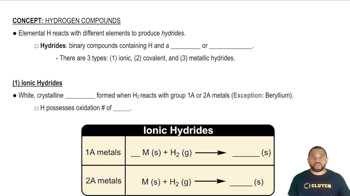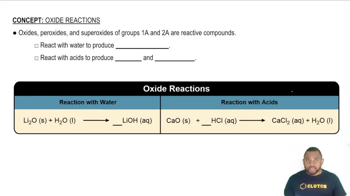Here are the essential concepts you must grasp in order to answer the question correctly.
Ionic Hydrides
Ionic hydrides are compounds formed between metals and hydrogen, where hydrogen acts as a hydride ion (H-). These hydrides typically form with alkali and alkaline earth metals, which have low electronegativities and readily lose electrons to hydrogen. The nature of ionic hydrides suggests that the metal's properties will influence the type of oxides it forms.
Recommended video:
Acidic vs. Basic Oxides
Oxides can be classified as acidic, basic, or amphoteric based on their behavior in reactions with acids and bases. Basic oxides, often formed by metals, react with acids to produce salts and water, while acidic oxides, typically formed by nonmetals, react with bases. The classification is crucial for predicting the behavior of oxides formed by elements that also form ionic hydrides.
Recommended video:
Periodic Trends
Periodic trends refer to the predictable patterns in elemental properties across the periodic table, such as electronegativity, ionization energy, and metallic character. Elements that form ionic hydrides are usually found in the left side of the periodic table, where metallic character is high. This trend indicates that such elements are more likely to form basic oxides, as they tend to lose electrons easily and react with acids.
Recommended video:
 Verified step by step guidance
Verified step by step guidance

